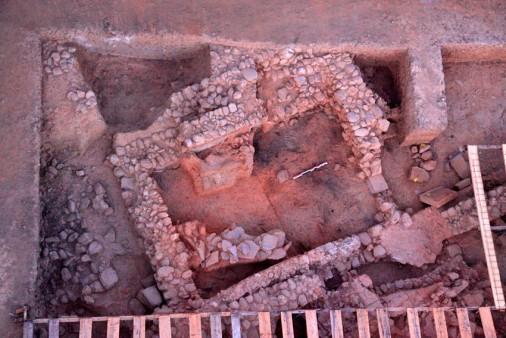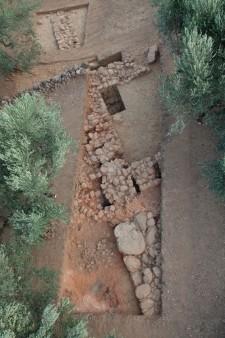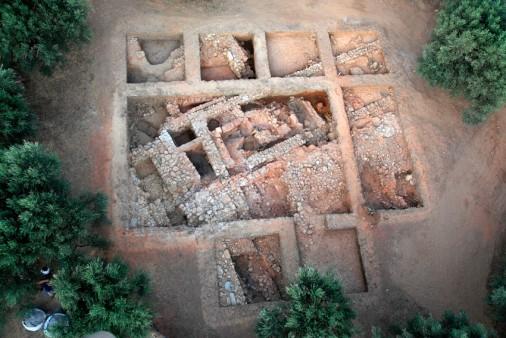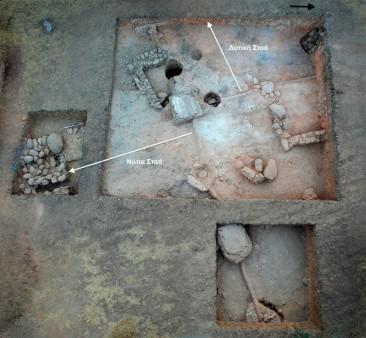Source - http://www.archaiologia.gr/en/blog/2013/09/12/from-xirokambi-laconia-to-shanghai/

Aghios Vassilios of Xirokambi: Room A10 (excavation season 2012).
It is one of the most interesting and most promising Greek excavations, whose distinction in an international archaeological forum may seem natural, but it’s not to be taken for granted. Ongoing surveys in Aghios Vassilios of Xirokambi (Municipality of Sparta), in Laconia, led by the Emeritus Ephor of Antiquities Adamantia Vasilogamvrou, have brought to light finds which confirm the importance of the archaeological site, such as the remains of a Mycenaean palace, Linear B tablets, numerous fragments of wall paintings, bronze swords, and various valuable objects.
The excavation, along with nine others from all over the world, was presented during the inaugural Shanghai Archaeology Forum (SAF), held from the 23rd through the 26th of August 2013 at the China Art Museum of Shanghai. Given the fact that no other survey conducted on European ground was included in SAF’s programme, the distinction is regarded to be very important for the Aghios Vassilios team and for Greece.
Out of 99 surveys, initially proposed and belonging to two categories (new field surveys and research programmes), the Archaeological Programme of Aghios Vassilios in Xirokambi of Laconia made it to the final list of the ten new field surveys presented in Shanghai, as Mrs. Vasilogamvrou said to ANA-MPA. Nine surveys were chosen for the second category.
Referring to the fact that the SAF brought together archaeologists and researchers who study civilizations in different parts of the planet, Mrs. Vasilogamvrou commented: “Especially for us Greek archaeologists, I think this contact [with other scientists of different civilizations] is of special interest: It helps us come out for a while from the field of Greek-Roman civilization, in which we are somehow shut off – of course with good reason, given the richness and range it has in modern Western world”. She added that these kind of events place Greek culture in the overall framework in a more appropriate way. “The fact that our culture is very important and that it has left its mark on Western culture is indisputable. Nevertheless, this given fact often proves to be restrictive for us. On the other hand, it tends to be very mind-broadening if one sees the ‘big picture’, in other words, when one realizes that at the same time other things are happening all over the planet. Personally, I think this was the most important thing about the Forum. Apart from the fact, of course, that one gets to see how programmes work in other countries, the pros and cons – it is very helpful” she pointed out.
Eveything started when Professor of Classical Archaeology at the University of Athens Olga Palagia submitted a proposal about Aghios Vassilios to the Nomination Committee of SAF. After a strict evaluation procedure, carried out by the Selection Committee, consisting of 40 scientists from different parts of the world, the final selection of the Greek excavation was a fact.
The presentation, made on the 23rd of August in Shanghai and in front of a big international audience, draw the attention of many people, not only archaeologists. Among them was Professor Lord Colin Renfrew, an eminent archaeologist, regular visitor and researcher of Greece, whose contribution in the fight against looting is very significant. “After our presentation, he came and asked a lot of things about Aghios Vassilios. We had a very constructive conversation” says Mrs. Vasilogamvrou. “Another fact that surprised me was that out of 19 surveys which were selected for the SAF only three are led by women (…). I think this is strange, given the fact that –in Greece, at least– the field of archaeology is largely dominated by women.
The Shanghai Archaeology Forum –which will be held every two years– is a non-profit organization promoting “the investigation, presentation, and protection of the world’s archaeological resources and heritage. It serves as an international platform for the illumination of archaeological research and its significance and relevance to the world today”. The forum is fully committed to excellence through innovation and cooperation, and to the sustainable development of human society.
Excavations in Aghios Vassilios of Xirokambi in Laconia

Until recently, Laconia was regarded an exception in the map of the Peloponnese Mycenaean palaces, even though –according to myth– its queen, Helen, was the cause of the Trojan War (the Homeric epics are an important source of information about the topography, the social and political organization and the habits of the Mycenaean era). This raised a lot of questions about the politics and the administrative organization of Laconia during that period.

Aghios Vassilios of Xirokambi: The east side of «Building D» (excavation season 2011).
Answers to these questions slowly began to emerge in 2008, when clay tablets with Linear B came to light at the archaeological site of Aghios Vassilios, near Xirokambi. The tablets suggested the possible existence of an archive, a sort of register, within the site, which would provide strong evidence for the fact that there was a palatial-administrative center at the site. The Linear B texts are referring to two important production units: one of perfume substances and the other of fabrics, both operating within the palatial centres and controlled by them. Also found were a big number of artefacts related to weapons, a characteristic type of vessel and an object of symbolic value, the double axe.

Aghios Vassilios of Xirokambi: «Building A» (excavation season 2011)
The excavation data and the deciphered texts of the tablets –which prove a very pedantic bureaucratic organization and a powerful administrative background– confirm the significance of the settlement in matters of administrative structures in Laconia of the Mycenaean era. This is why the Archaeological Programme of Aghios Vassilios was initiated for the systematic archaeological survey of the site, under the auspices of the Archaeological Society at Athens, led by Mrs. Vasilogamvrou and joined by numerous scientists of various fields.

Aghios Vassilios of Xirokambi: The southwestern corner of the Central Court, with parts of the South and West Stoa (excavation season 2012).
The systematic survey is being conducted since 2010, on the hill where the Post-Byzantine church of Aghios Vassilios is located. From that spot one can see all other Mycenaean sites of the valley. The Mycenaean settlement covers the narrow hills of the Sparta plain, approximately 11,5 klm south of the city, not far from Xirokambi.
The main building phase of the three Mycenaean buildings which are being excavated dates back to the 14th century BC. During that time construction works in Aghios Vassilios were intensive. Moreover, elements related to the organization and architecture of the buildings during that period point to contact with Crete. One of the buildings investigated is connected with functions of social and religious nature, while in the extensive destruction layer remains of a symposium, figurines, seal stones, clay and bronze vessels and 21 bronze swords were found. The numerous fragments of wall paintings show that the buildings of Aghios Vassilios had painted decoration, as did the rest of the Mycenaean centers of mainland Greece and the Aegean. A fire which broke out at the end of the 14th century BC or the beginning of 13th century BC, destroyed the buildings, which were not rebuilt at the same location.
The discovery of the palatial centre of Aghios Vassilios is very important for the study and understanding of Mycenaean era, not only in Laconia, but in all parts of mainland Greece, as Mrs. Vasilogamvrou and her team point out, after having completed the excavation period for 2013, on the 20th of August, and having enriched Aghios Vassilios’ archive by new fragments of tablets.